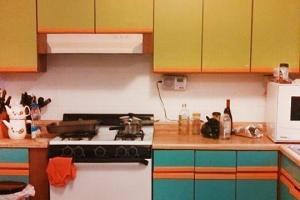Revitalize Your Space: A Comprehensive Guide to Refinishing Particle Board Cabinets

-
Quick Links:
- Introduction
- Understanding Particle Board
- Why Refinish Particle Board Cabinets?
- Preparation Steps
- Step-by-Step Refinishing Process
- Finishing Touches
- Case Studies
- Expert Insights
- FAQs
Introduction
Refinishing particle board cabinets can breathe new life into your home. These affordable yet versatile pieces of furniture often come with a bland finish, but with the right techniques, you can turn them into stunning focal points. This guide will provide you with everything you need to know about refinishing particle board cabinets, from understanding the material to the final touches that make your cabinets shine.
Understanding Particle Board
Particle board is an engineered wood product made from wood chips, sawmill shavings, or sawdust, combined with a resin adhesive under high pressure. While it’s known for being cost-effective, it also has its drawbacks, including susceptibility to moisture and damage. Knowing its properties is crucial for a successful refinishing project.
Characteristics of Particle Board
- Cost-effective and lightweight
- Available in various thicknesses
- Easy to cut and shape
- Prone to warping and swelling when exposed to moisture
Why Refinish Particle Board Cabinets?
Refinishing your particle board cabinets offers several benefits:
- Cost Savings: Rather than purchasing new cabinets, refinishing is a more economical choice.
- Customization: You can choose colors and finishes that align with your home’s aesthetic.
- Environmental Impact: Refinishing reduces waste by repurposing existing materials.
- Increased Home Value: Updated cabinets can enhance the overall value of your home.
Preparation Steps
Before you start refinishing, proper preparation is essential to achieve the best results. Follow these steps:
Gather Your Tools and Materials
- Sandpaper (120 and 220 grit)
- Paint or stain (suitable for particle board)
- Primer (optional)
- Paintbrush or roller
- Protective gear (mask, gloves, goggles)
- Drop cloths or tarps
- Cleaning supplies (mild detergent, rags)
Clean the Cabinets
Remove all contents from the cabinets and clean them with a mild detergent to remove grease, dirt, and grime. Ensure that the surface is completely dry before moving on.
Assess Damages
Inspect your cabinets for any damages or imperfections. Minor scratches can be sanded down, while major damages may require filling in with wood filler.
Step-by-Step Refinishing Process
1. Sanding
Begin by sanding the surface of the cabinets to remove the existing finish. Start with 120 grit sandpaper, and then move to 220 grit for a smooth finish. Always sand in the direction of the wood grain.
2. Applying Primer (Optional)
If you are painting the cabinets, applying a primer helps the paint adhere better and improves the finish. Choose a primer suitable for particle board.
3. Painting or Staining
Apply your chosen paint or stain using a brush or roller. If you’re painting, consider using a high-quality latex paint for durability. For staining, ensure the stain is compatible with particle board.
4. Sealing
Once the paint or stain is completely dry, seal the cabinets with a clear topcoat to protect the finish. Polyurethane or lacquer can be good options.
Finishing Touches
After the refinishing process, consider updating hardware like knobs and handles for a fresh look. This small change can significantly enhance the overall aesthetic.
Case Studies
Here are a few examples of successful refinishing projects:
Case Study 1: The Kitchen Transformation
A homeowner completely transformed their outdated kitchen by refinishing their particle board cabinets in a bright white finish. They documented the process and shared it on social media, attracting attention for their budget-friendly makeover.
Case Study 2: The Eco-Friendly Approach
Another homeowner used eco-friendly paints and stains to refinish their particle board cabinets. The project not only updated their kitchen but also aligned with their sustainability goals.
Expert Insights
We consulted with interior design experts to provide additional tips:
Tip 1: Don’t Rush the Process
Allow ample drying time between coats to ensure a professional finish.
Tip 2: Choose the Right Finish
Consider matte, satin, or gloss finishes based on your desired aesthetic and durability needs.
FAQs
1. Can I paint over particle board without sanding?
While you can paint without sanding, sanding will provide better adhesion for the paint.
2. How do I prevent particle board from swelling when refinishing?
Ensure that the surface is fully sealed and avoid moisture exposure during the process.
3. What type of paint is best for particle board cabinets?
A high-quality latex or acrylic paint is recommended for durability and finish.
4. How long does it take to refinish particle board cabinets?
The entire process can take a few days, depending on drying times and the number of coats applied.
5. Is it necessary to use a primer?
While not mandatory, using a primer can enhance adhesion and improve the final appearance.
6. Can I use a spray paint on particle board?
Yes, spray paint can be used, but ensure you apply it in thin, even coats.
7. What should I do if the particle board is damaged?
Minor damages can be sanded out, while deeper scratches may need wood filler.
8. How do I clean my refinished cabinets?
Use a gentle soap solution and a soft cloth to avoid damaging the finish.
9. Can I stain particle board like solid wood?
Staining can be done, but results may vary due to the particle board's composition.
10. What is the lifespan of refinished particle board cabinets?
With proper care, refinished cabinets can last several years, especially with a protective sealant.
Random Reads
- How to remove system volume information folder
- How to test your lcd display on android
- How to test fluorescent bulbs
- How to save on new super mario bros ds
- How to reattach a keyboard key
- How to replace halogen downlights with led
- How to replace fluorescent lighting
- The ultimate guide to winning strategies in fortnite
- How to hang on stucco without drilling
- How to hang heavy mirror